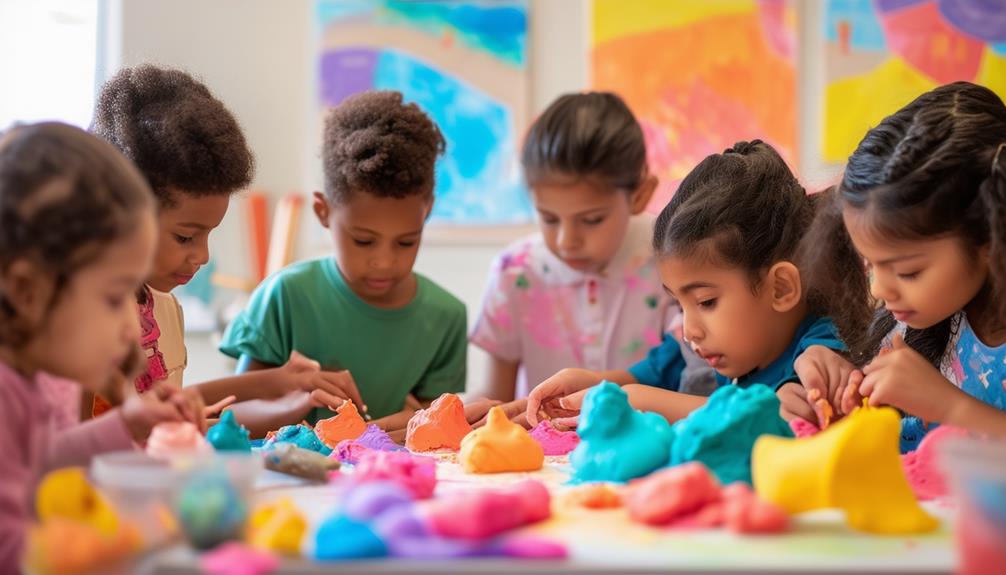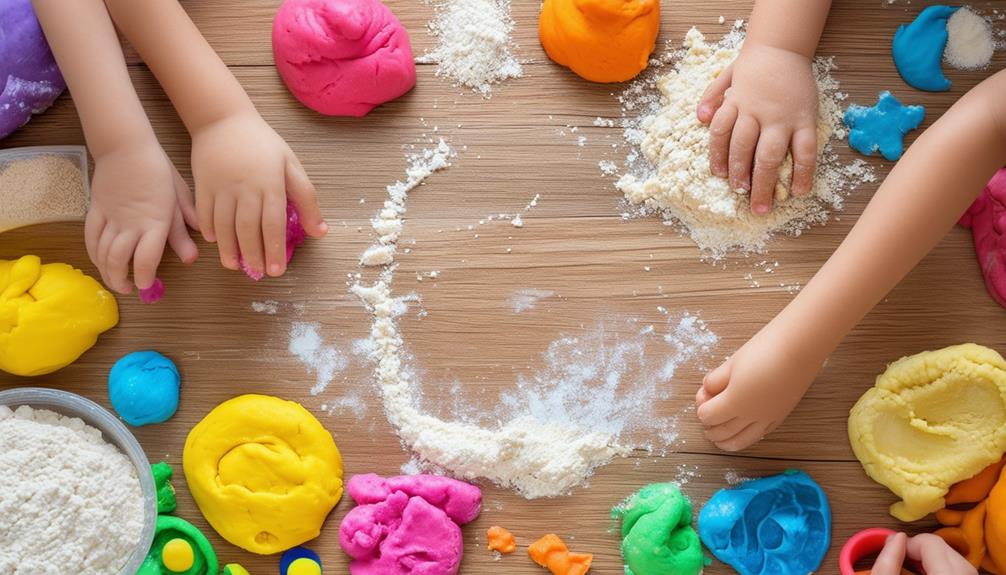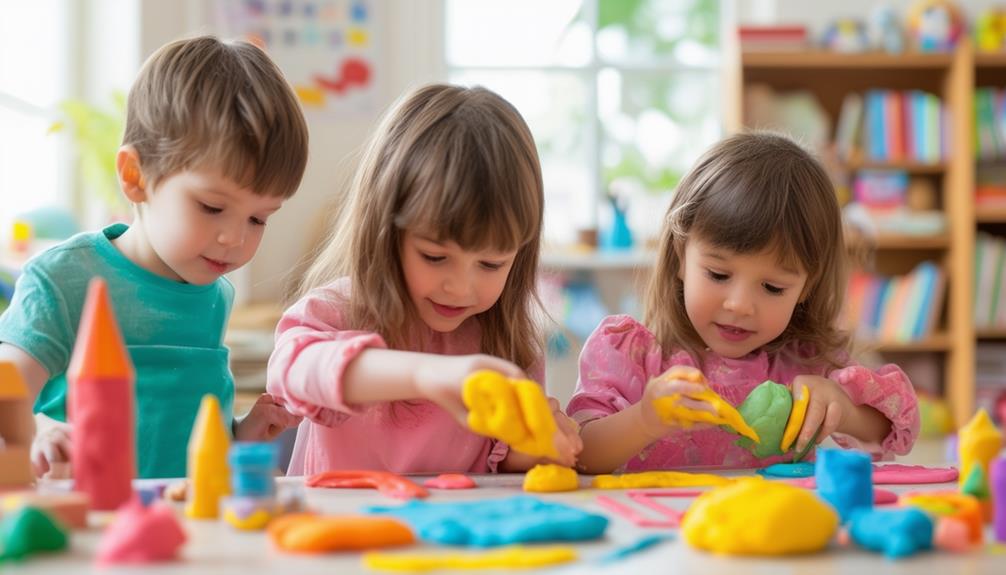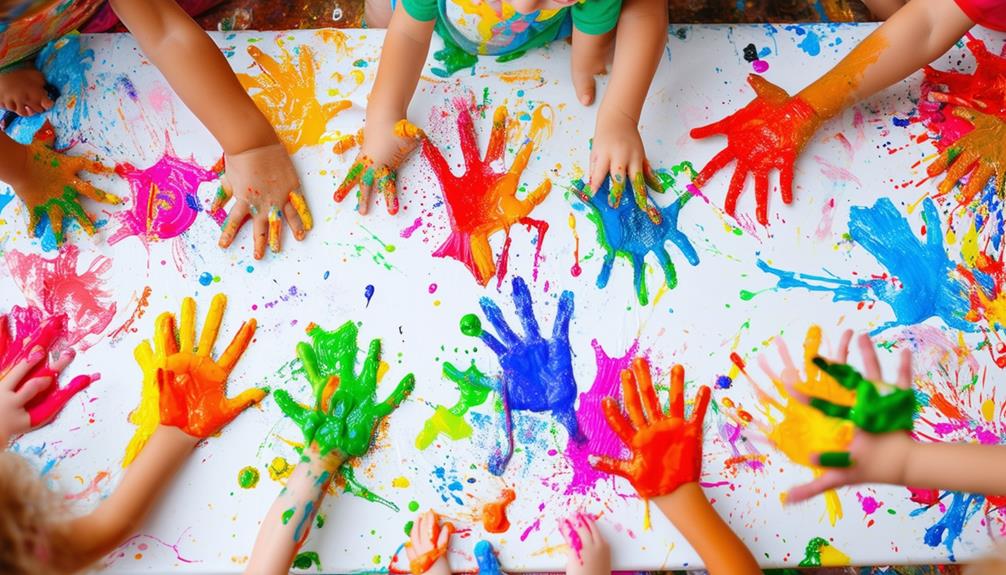Playdough Storytelling: How to Use Playdough in Creative Writing

Imagine using playdough to bring your stories to life, making the writing process more interactive and engaging. By shaping characters, settings, and plot points with your hands, you create a tangible connection to your narrative. This method stimulates creativity, strengthens memory, and enhances sensory development. Curious about how this hands-on approach can transform storytelling and enrich writing skills? Let's explore the materials, steps, and benefits, uncovering a dynamic way to make creative writing both fun and educational.
Materials Needed
To begin your playdough storytelling adventure, you'll need the following materials: various colors of playdough, a storybook or narrative, and a flat surface for molding. These items are essential for creating an engaging and interactive storytelling experience. The assortment of playdough colors will allow you to craft detailed visual representations of characters, settings, and key elements of the story, enhancing the overall narrative.
First, choose a storybook or narrative to re-tell using playdough. This will provide a structured framework for your activity, ensuring that you stay focused and coherent throughout the storytelling process. A clear storyline enriches the creative process and helps maintain consistency.
A flat surface is crucial for molding your playdough creations, providing the stability needed to shape and display your characters and scenes effectively. Additionally, consider using optional props like small figurines to add depth and bring your story to life in unexpected ways.
Writing Process Steps
Start your playdough storytelling project by brainstorming and shaping your favorite foods to spark creativity. Imagine creating a playdough pizza or a vibrant fruit salad. These detailed representations will help you visualize story elements more vividly. As you sculpt each piece, think about the story you want to tell. Which characters might love these foods? What adventures could they embark on?
Once your playdough creations are ready, share them with peers for feedback. This collaborative step is crucial for refining your ideas. Pay close attention to suggestions and be open to modifying your playdough models. Editing is an essential part of the writing process, and making necessary adjustments will strengthen your story structure.
After revisions, finalize your playdough masterpieces. Showcase your completed creations, reflecting on the process from brainstorming to completion. This final step allows you to appreciate the effort and creativity invested in each phase of the writing process. By using playdough, you have not only crafted a story but also engaged in a hands-on, imaginative experience.
Benefits of Hands-On Learning

Engaging in hands-on learning with playdough stimulates children's sensory development and nurtures creativity. When children manipulate playdough, they activate their tactile senses, enhancing sensory development. This activity is more than just enjoyable; it's an educational tool that promotes creativity and fine motor skills, supporting cognitive growth.
Experimenting with playdough allows children to explore and express ideas, fostering imagination. It turns abstract concepts into tangible experiences, aiding in the comprehension of complex ideas such as the writing process.
Here are four key benefits of hands-on learning with playdough:
- Sensory Development: Molding playdough improves fine motor skills and engages multiple senses.
- Creativity Enhancement: Playdough activities stimulate imaginative thinking and idea expression.
- Cognitive Support: Handling playdough helps in understanding complex concepts and processes.
- Active Participation: It encourages collaboration and active engagement, making the learning environment more dynamic.
Incorporating playdough into teaching methods can make learning more effective and enjoyable, transforming abstract lessons into hands-on experiences that resonate with young learners.
Playdough Activities for Writing Stages
Using playdough to shape characters and settings makes story creation more tangible and enjoyable. As students visualize key elements, they develop richer narratives. Sequencing and storytelling become easier as they mold different scenes and plot points, aiding in comprehension and engagement.
Shaping Characters and Settings
Using playdough to shape characters and settings helps students visualize their stories before they start writing. By molding these elements, students can better understand their story components and create a tangible connection to their narrative ideas. Here's how to incorporate playdough effectively:
- Character Creation: Have students mold their main characters using playdough. Encourage them to consider details like facial expressions and body language, which can help in crafting more dynamic and relatable characters.
- Setting the Scene: Ask students to construct the primary settings of their stories. Whether it's a bustling city or an enchanted forest, having a physical representation can make it easier to describe these places vividly in their writing.
- Plot Arrangement: During the drafting phase, use playdough to represent key plot points. Students can rearrange these elements to find the most captivating sequence for their narrative.
- Revising Characters and Settings: In the revising process, students can modify their playdough models to reflect changes in their stories, ensuring that their written descriptions align with their visualized ideas.
Using playdough in these ways not only makes the pre-writing stage more interactive but also enriches students' creativity and engagement in the writing process.
Visualizing Story Elements
Using playdough activities throughout the writing process can significantly enhance students' ability to visualize and articulate story elements. In the pre-writing stage, playdough allows students to shape characters or settings, sparking creativity and providing tangible references for their narratives.
During drafting, molding key story elements with playdough helps students bring their ideas to life, making abstract concepts more concrete. For example, sculpting a pivotal scene can guide them in logically structuring their story.
In the revising stage, playdough is invaluable for rearranging plot points or character arcs, allowing for tactile exploration of different narrative possibilities. This flexibility can lead to a deeper understanding and refinement of their work.
When editing, creating word shapes with playdough can help students practice spelling and grammar skills in an engaging way. In the publishing phase, crafting final story elements with playdough enhances presentations and reflects the writing process.
Sequencing and Storytelling
Playdough activities can seamlessly integrate into each stage of the writing process, enhancing sequencing and storytelling skills for students. Whether you're working on pre-writing, drafting, revising, editing, or publishing, playdough offers a hands-on approach to developing narrative structure.
- Pre-writing: Use playdough to brainstorm and shape characters, settings, and key story elements. This tactile method helps solidify ideas before writing.
- Drafting: Students can mold playdough to represent different plot points or character arcs during drafting. This helps visualize the story flow.
- Revising: Rearranging playdough models of plot points allows students to experiment with different sequences, exploring how changes affect the narrative.
- Editing: Playdough can be used to create word shapes, helping students focus on spelling and grammar, making the editing process more engaging.
- Publishing: Playdough can help craft final story elements, making the presentation visually appealing.
Incorporating playdough into these writing stages not only makes the process enjoyable but also reinforces essential sequencing skills.
Multisensory Learning Benefits

Incorporating playdough into storytelling engages students visually and enhances their sensory development through touch and movement. This multisensory approach improves memory retention by involving multiple senses. It ensures active participation and makes creative writing activities enjoyable for students.
Enhancing Sensory Development
Engaging in playdough activities significantly enhances children's sensory development by providing rich tactile experiences that stimulate touch, sight, and creativity. Utilizing playdough in creative exercises isn't merely about shaping figures; it involves activating multiple senses to foster comprehensive learning.
Here's how playdough aids sensory development:
- Touch: Manipulating the dough enhances fine motor skills and tactile perception.
- Sight: Working with various colors and forms promotes visual discrimination and creativity.
- Smell: Scented playdough adds an olfactory dimension, making the learning experience more memorable.
- Kinesthetic Learning: The physical act of handling playdough benefits kinesthetic learners by engaging their whole body in the learning process.
Promoting Memory Retention
Playdough storytelling enhances memory retention through multisensory learning. Engaging in playdough activities activates visual, tactile, and kinesthetic senses, enriching memory retention by creating more neural connections in the brain.
Hands-on activities like playdough storytelling require active participation, which is crucial for memory recall. The physical act of molding shapes and characters embeds the story's elements more deeply into memory. Sensory experiences with playdough stimulate neural pathways, facilitating easier retention and recall of information.
Using multiple senses during learning increases cognitive engagement, aiding memory consolidation. In playdough storytelling, details are more likely to be remembered because they are encoded through various sensory channels. This method supports long-term memory retention, particularly in educational settings where retaining information is essential.
Playdough activities offer a unique way to encode information, making it more memorable. By engaging multiple senses, learning becomes an active process, building a stronger, more reliable memory foundation.
Activity Overview
By molding playdough into characters and settings, children actively bring stories to life, enhancing both comprehension and creativity. This hands-on approach to storytelling is not only enjoyable but also serves as a powerful educational tool. Playdough storytelling involves young children creating visual representations of key parts of a story. They mold playdough to form characters, settings, and plot elements, which allows for deep engagement with the material.
Here's a quick guide on incorporating playdough storytelling into your activities:
- Select a Story: Choose a simple story appropriate for the children's developmental stage. Options could include well-known fairy tales or short narratives.
- Divide the Story: Break the story into key scenes or moments for the children to recreate with playdough.
- Create and Play: Provide playdough and encourage the children to mold characters and settings for each scene, using their imagination and creativity.
- Retell the Story: Have the children use their playdough creations to retell the story, fostering language and communication skills as they describe their visual representations.
Student Engagement and Learning Outcomes

Incorporating playdough storytelling into the classroom significantly boosts student motivation and participation. This interactive approach to creative writing leverages students' natural curiosity, greatly enhancing engagement. By molding playdough to create characters and settings, students gain a deeper understanding of literary concepts, thereby improving both comprehension and retention.
Playdough activities also contribute to a positive classroom environment. When students feel empowered to express their creativity, they are more inclined to take risks and share their ideas. This empowerment fosters an inclusive and dynamic learning space where all students feel valued.
Furthermore, playdough storytelling supports differentiated instruction, accommodating various learning styles. Visual learners benefit from seeing their ideas take shape, while kinesthetic learners thrive on hands-on activities. Thus, playdough serves as a versatile tool for engagement.
In addition to fostering creativity, playdough activities help students develop analytical skills. As they interpret and reflect on character traits, they build critical thinking skills essential for literary analysis. Overall, integrating playdough into creative writing tasks enhances student engagement and learning outcomes.




